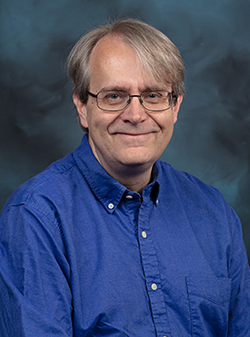Star-Stuff, Indeed
October 19, 2023
We are made of star-stuff, Carl Sagan said in the Cosmos TV series.
William Raphael (Raph) Hix knew that quote. As a high school kid in Maryland he'd taken advanced physics and chemistry. He'd watched Cosmos and heard Sagan talk about stars and elements. But something changed when he encountered this concept in one of his college astronomy textbooks. It took on a gravitas that has captivated him ever since, leading him to climb inside stars (theoretically) to see how the stuff that makes us—carbon, iron, etc.—came to be.
For his "contributions to understanding explosive thermonuclear burning and nucleosynthesis, particularly in contexts like supernovae," Hix, a UT-Oak Ridge National Laboratory joint faculty professor, has been elected a Fellow of the American Physical Society. This honor is bestowed on only one half of one percent of the Society's membership each year. Hix is one of 153 Fellows in the 2023 cohort and the second UT physicist elected in the past two years.
Adrian Del Maestro, UT Physics Professor and Department Head, had high praise for the department's newest APS Fellow.

Raph Hix (courtesy: ORNL)
"Dr. Hix is exemplary of the unique and visionary researchers that bridge the University of Tennessee and Oak Ridge National Lab as joint faculty," he said. "He is a driving force behind our astrophysics program and is a sought-after mentor and teacher, involving both graduate and undergraduate students in his cutting-edge research on stellar evolution."
Hix is interested in how the chemical elements are made, or nucleosynthesis. The Big Bang gave us hydrogen, helium, and lithium. Since then, nuclear reactions accompanying the life and death of stars have created most of the other elements. As it turns out, stars are late bloomers.
"Most of the elements get made at the end of a star's life," he said.
Stars run on the fusion of hydrogen into helium for most of their lives. Hix explained that as a star begins to run out of fuel, temperatures go up and conditions become more extreme. That's when the heavier elements, like carbon and iron, are made. Once the fuel is exhausted, an ordinary star (like our Sun) violently expels its outer layers, including elements made late in its life, and becomes a white dwarf. For more massive stars, like Betelgeuse, Rigel and Antares, the exhaustion of fuel leads to a supernova—sending those recently made elements into the cosmos—while the stellar core collapses, leaving a neutron star or a black hole.
With colleagues at ORNL and UT, Hix develops sophisticated models to understand how all this works. He leads ORNL's Theoretical and Computational Physics group, utilizing some of the national lab's powerful tools, like Summit and Frontier.
"We use the biggest supercomputer we can to model as much physics as possible within the intricate workings inside a star that we (then) blow up," he said.
The results become part of a chain of handing off data—ultimately going to scientists who use telescopes to see if the model holds up to observation. Hix explained this is how they prove their models are accurate.
"It's a way to climb inside a star and see the parts that are ordinarily hidden from view," he said.
Hix finished undergraduate studies at the University of Maryland at College Park, where he re-discovered Sagan's quote and graduated with bachelor's degrees in physics and astronomy as well as math. He earned AM and PhD degrees in astronomy at Harvard University. Following a postdoctoral appointment at the University of Texas, he came to UT in Knoxville. He began as a postdoc, became a research professor, and then in 2004 moved (without moving) to ORNL. In 2010, he rejoined the UT faculty with a joint faculty appointment.
In his case, he explained, being joint faculty means that he's an ORNL astrophysicist and the university subcontracts half of his time to teach courses (like Honors Introductory Astronomy) and supervise students. Hix said he really enjoys working with undergraduates. He loves seeing how excited they are when they come to the national lab and have an office for the summer. He likes being reminded, he said, "of that time in my career when everything was cool and new and interesting."
The APS Fellowship Program was created to recognize members who may have made advances in physics through original research and publication, or made significant innovative contributions in the application of physics to science and technology. They may also have made significant contributions to the teaching of physics or service and participation in the activities of the Society.
Raph Hix is the 10th APS Fellow on UT's current faculty.